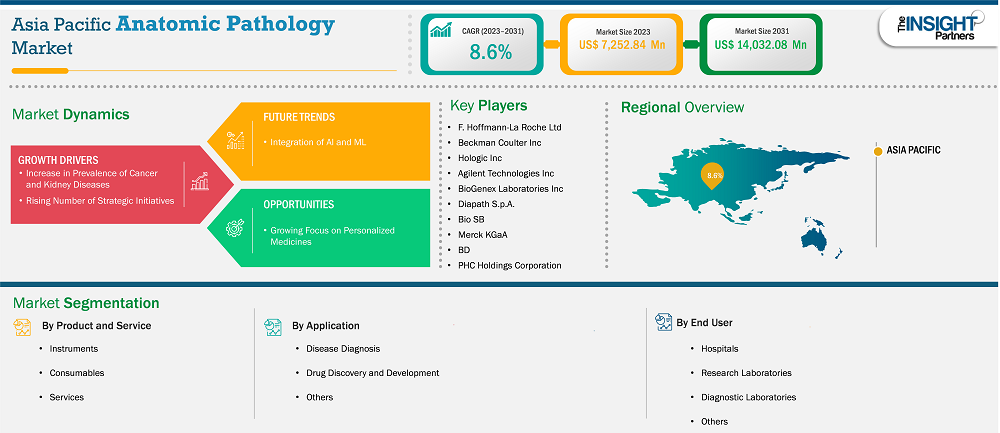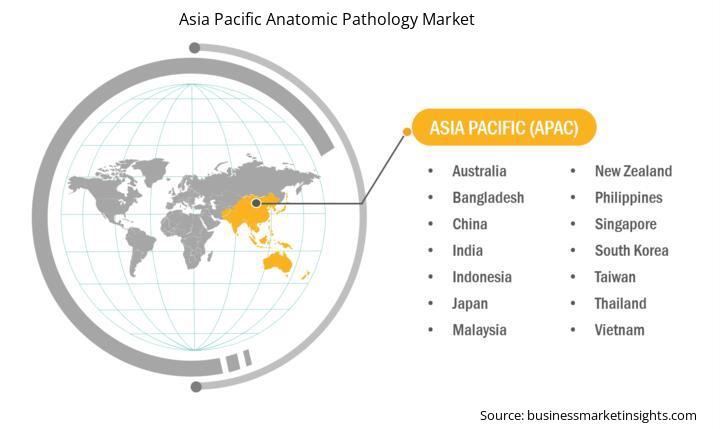Asia Pacific Anatomic Pathology Market Report (2021-2031) by Scope, Segmentation, Dynamics, and Competitive Analysis
No. of Pages: 135 | Report Code: TIPRE00026303 | Category: Life Sciences
No. of Pages: 135 | Report Code: TIPRE00026303 | Category: Life Sciences
The anatomic pathology market size is expected to reach US$ 14,032.08 million by 2031 from US$ 7,252.84 million in 2023. The market is estimated to record a CAGR of 8.6% from 2023 to 2031.
China, Japan, India, Australia, and South Korea are among the major countries in the anatomic pathology market in Asia Pacific. The analysis also includes an evaluation of the market in the rest of the countries in the region. The anatomic pathology market growth in this region is ascribed to a rise in the incidence of chronic diseases over the years, and the integration of digital solutions and pathology tools. Moreover, countries such as Australia and South Korea are likely to offer significant growth opportunities to the market players with their continuously advancing healthcare sectors.
Asia Pacific Anatomic Pathology Market Strategic Insights

Asia Pacific Anatomic Pathology Market Segmentation Analysis
Key segments that contributed to the derivation of the anatomic pathology market analysis are product and services, application, and end user.
Digital pathology, a growing subfield within anatomical pathology, uses digital technologies to streamline data collection and management. It helps reduce risks to specimen samples and has the potential to accelerate enrolment in clinical trials. Additionally, digital pathology can reduce sample-to-result turnaround time and streamline the central pathology review process, further offering opportunities to increase trial efficiency.
To introduce upgraded technologies, machine learning (ML) and artificial intelligence (AI) are integrated with digital pathology for proper analysis and management of data. Several anatomic pathology laboratories are becoming increasingly aware of the benefits of digitization and AI in practice. Moreover, recent technological advancements and regulatory approvals are encouraging the digitalization of laboratory operations to improve the speed and accuracy of processes. With AI and ML, pathologists will have an augmented ability to improve diagnostic accuracy, efficiency, and consistency.
In November 2023, Dedalus Group and Ibex Medical Analytics launched a fully integrated End-to-End AI-powered Digital Pathology Solution for cancer diagnostics. It enables complete digitization of anatomic pathology labs with a next-generation Anatomic Pathology Information System (AIS) and DP solution, harnessing the power of data and AI for assisted case prioritization, advanced image analysis, and reproducible diagnoses. The rising focus on integrating AI technology for anatomical pathology processes due to its benefits is expected to act as a trend and is expected to fuel the growth of the market in the forecast period.
Based on country, the Asia Pacific anatomic pathology market comprises China, Japan, India, Australia, South Korea, and the Rest of Asia Pacific. China held the largest share in 2023.
In China, cancer has arisen as a significant public health concern affecting the lives of its citizens. According to the World Health Organization (WHO), the country recorded 4.57 million new cancer diagnoses and 3.00 million cancer-related deaths in 2020, ranking first in both these parameters globally. As a result, the emphasis has switched to the early screening, diagnosis, and treatment of cancer cases. In the last two decades, the Chinese central government has launched a series of large-scale cancer screening programs in the form of "transfer payment," such as the "Cancer Screening Program in Rural Areas (2005)," "Cancer Screening Program in Huai River Areas (2007)," "Cervical Cancer and Breast Cancer Screening Program for Women in Rural Areas (2009)," and "Cancer Screening Program in Urban Areas (2012)." These programs have increased population-wide screenings for esophageal, gastric, colorectal, liver, cervical, breast, and other high-risk malignancies. Such strategies contribute significantly to cancer prevention and control in the primary medical facilities throughout China. Furthermore, the country is shifting from traditional pathological diagnosis to digital pathology. According to the China White Paper on Digital Pathology published by the Shanghai Digital Medicine Innovation Center and Beijing-based Equal-Ocean in 2022, 40% of hospitals surveyed are in the process of building or have already established a digital pathology system. More than half of these hospitals have invested over 1 million yuan (US$ 147,620) in digital pathology systems, with some spending more than 5 million yuan each. In addition, the white paper mentioned that ~23% of remote clinical consultations utilized digital pathology in 2022. Thus, with growing investments in the healthcare sector and increasing initiatives for cancer screening, the demand for anatomic pathology tools and digital solutions is rising in China.
Asia Pacific Anatomic Pathology Market Report Highlights
Report Attribute
Details
Market size in 2023
US$ 7,252.84 Million
Market Size by 2031
US$ 14,032.08 Million
CAGR (2023 - 2031) 8.6%
Historical Data
2021-2022
Forecast period
2024-2031
Segments Covered
By Product and Services
By Application
By End User
Regions and Countries Covered
Asia Pacific
Market leaders and key company profiles
Asia Pacific Anatomic Pathology Market Company Profiles
Some of the key players operating in the market include F. Hoffmann-La Roche Ltd, Beckman Coulter Inc, Hologic Inc, Agilent Technologies Inc, BioGenex Laboratories Inc, Diapath S.p.A., Bio SB, Merck KGaA, and PHC Holdings Corporation among others. These players are adopting various strategies such as expansion, product innovation, and mergers and acquisitions to provide innovative products to their consumers and increase their market share.
The following methodology has been followed for the collection and analysis of data presented in this report:
The research process begins with comprehensive secondary research, utilizing both internal and external sources to gather qualitative and quantitative data for each market. Commonly referenced secondary research sources include, but are not limited to:
Note: All financial data included in the Company Profiles section has been standardized to USD. For companies reporting in other currencies, figures have been converted to USD using the relevant exchange rates for the corresponding year.
The Insight Partners’ conducts a significant number of primary interviews each year with industry stakeholders and experts to validate its data analysis, and gain valuable insights. These research interviews are designed to:
Primary research is conducted via email interactions and telephone interviews, encompassing various markets, categories, segments, and sub-segments across different regions. Participants typically include:

The Asia Pacific Anatomic Pathology Market is valued at US$ 7,252.84 Million in 2023, it is projected to reach US$ 14,032.08 Million by 2031.
As per our report Asia Pacific Anatomic Pathology Market, the market size is valued at US$ 7,252.84 Million in 2023, projecting it to reach US$ 14,032.08 Million by 2031. This translates to a CAGR of approximately 8.6% during the forecast period.
The Asia Pacific Anatomic Pathology Market report typically cover these key segments-
The historic period, base year, and forecast period can vary slightly depending on the specific market research report. However, for the Asia Pacific Anatomic Pathology Market report:
The Asia Pacific Anatomic Pathology Market is populated by several key players, each contributing to its growth and innovation. Some of the major players include:
The Asia Pacific Anatomic Pathology Market report is valuable for diverse stakeholders, including:
Essentially, anyone involved in or considering involvement in the Asia Pacific Anatomic Pathology Market value chain can benefit from the information contained in a comprehensive market report.